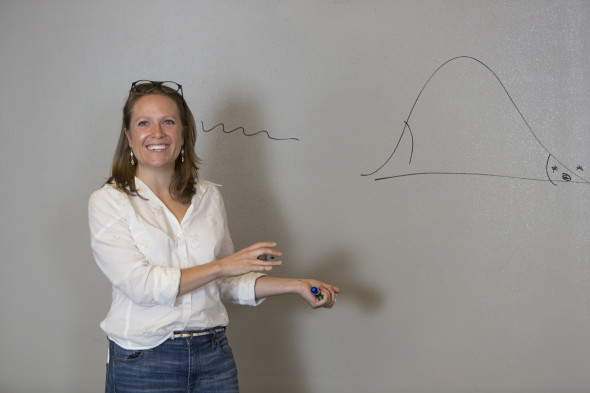Artificial intelligence used to be the stuff of science fiction.
Today, an IBM supercomputer named Watson is actually learning how to think, analyze unstructured data, translate, and react to natural language.
Zoe Hillenmeyer, BFA ’09, MBA ’13, says, “cognitive computing” is the term IBM prefers for this new era of intelligent technology. She is IBM’s innovation and design lead for Watson’s Cross Industry Value Team. In Hillenmeyer’s words, “We’re a tiger team of solution-focused technology geeks, with an eye to the future and the possibilities for cognitive computing to drastically transform complexity into context and confusion into well-informed decisions.”
Ironically, Hillenmeyer would be the first to admit that she is not your typical technology geek. She grew up in rural Indiana, where barely half of her senior class graduated from high school and she was one of a few to go out of state for college. After arriving at WashU, she discovered her passion for art and pursued a degree in sculpture. Hillenmeyer worked for a startup in India and an auction house in Boston, and organized cultural festivals before returning to St. Louis and Olin’s MBA program. She sums up her insatiable curiosity to learn as “a relentless pursuit of the unknown.”
“Zoe is a force of nature,” Joe Fox says of the energetic innovator who never passes up the chance to question the status quo. Fox, associate dean of graduate programs at Olin, remembers how Hillenmeyer hit the ground running as a first-year MBA. As a class leader, she revived the Olin Women in Business (OWIB) organization, improved recruitment tactics for women applicants, and strengthened Olin’s ties to national organizations like the Forté Foundation and the National Association of Women MBAs (NAWMBA).

At IBM, Hillenmeyer’s innovative approach to problem solving, data visualization, and collaboration on consulting projects has propelled her to Big Blue’s much-talked-about new business unit: Watson. Since winning Jeopardy! in 2011, Watson has evolved. The computer is able to interpret big data by identifying patterns, connections, and insights. Then it organizes the content into smaller chunks for humans to digest, interpret, discover solutions, and make decisions. Now Watson is its own business unit, strategy, and talent organization.
“My role in particular is to infuse our team with core design principles, innovation best practices, and a momentum that embraces and exudes positive change,” explains Hillenmeyer. Her team is part of the Watson Group based in IBM’s new global headquarters in New York City’s Silicon Alley, although Hillenmeyer is based in Seattle. The Watson Group has more than 2,000 employees globally. Hillenmeyer’s team works on projects from transit to nuclear decommissioning. The only limit to the scope of their work is impact: “it has to be important, solving real and salient needs of society or business. It has to transform, dramatically, the ways of today,” Hillenmeyer said.
Hillenmeyer’s office is equipped with Play-Doh, paints, sketch pads, white boards, markers of many colors, and a drill press.
The sculptor-turned-IBMer refuses to abandon those tactile tools while working in this new era of cognitive computing. She insists they help facilitate novel approaches to idea generation, problem solving, and process reinvention: “We collaborate. We innovate. We team. We break things, and fix ’em. We brainstorm and fail, and make beautiful things exist. It’s a great job.”
This article originally appeared in OlinBusiness magazine.
Photos by Jerry Naunheim Jr.



